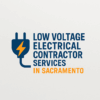Cost to Install Low Voltage Cabling in Sacramento: Complete 2025 Guide
Introduction
Installing low voltage cabling is a critical step for homes and businesses in Sacramento aiming to enhance connectivity, security, and efficiency. Whether it’s for networking, CCTV, intercom systems, or smart building applications, understanding the cost factors is essential to budget effectively. This guide breaks down pricing trends, installation methods, and expert tips to help Sacramento homeowners and business owners make informed decisions.
Table of Contents
- What is Low Voltage Cabling?
- Types of Low Voltage Cabling
- Factors Affecting Installation Costs in Sacramento
- Average Cost Estimates for Low Voltage Cabling
- DIY vs. Professional Installation
- Common Installation Mistakes to Avoid
- Future Trends in Low Voltage Cabling
- FAQs About Low Voltage Cabling in Sacramento
- Conclusion
What is Low Voltage Cabling?
Low voltage cabling refers to wiring systems that carry 50 volts or less, commonly used for:
- Network/data connections (Ethernet, fiber optic)
- Security and CCTV systems
- Audio/visual systems
- Intercom and access control systems
- Smart home automation
Unlike high-voltage electrical wiring, low voltage cabling is safer to install, less expensive to maintain, and ideal for modern communication and security needs.
Types of Low Voltage Cabling
1. Copper Cabling (Cat5e, Cat6, Cat6a)
- Uses: Ethernet, network, VoIP
- Cost: $0.20–$0.50 per foot for materials; $50–$150 per drop for professional installation
- Advantages: Reliable, widely supported, suitable for most small to medium networks
2. Fiber Optic Cabling
- Uses: High-speed data, long-distance connections
- Cost: $1–$6 per foot for materials; $150–$400 per drop installed
- Advantages: Higher bandwidth, future-proof, minimal signal loss
3. Coaxial Cabling
- Uses: CCTV, TV, broadband
- Cost: $0.50–$1 per foot for materials; $75–$200 per drop installed
- Advantages: Affordable, robust for video transmission
Factors Affecting Installation Costs in Sacramento
1. Type of Cable
Fiber optic is more expensive than copper or coaxial due to material and labor costs.
2. Project Size and Complexity
- Single-room home: lower labor costs
- Commercial buildings or multi-floor setups: higher labor, trenching, and conduit costs
3. Labor Rates in Sacramento
Professional installation ranges from $50–$150/hour depending on the expertise and licensing.
4. Accessibility
Hard-to-reach areas, walls, ceilings, or concrete floors increase labor and time.
5. Equipment and Additional Materials
Switches, patch panels, outlets, conduits, and junction boxes add to overall costs. How to Choose a Cabling Contractor in Sacramento
Average Cost Estimates for Low Voltage Cabling
| Installation Type | Average Cost (Material + Labor) | Notes |
|---|---|---|
| Residential Ethernet (Cat6) | $200–$500 per drop | Standard home office setup |
| Commercial Ethernet | $150–$400 per drop | Depends on building size & floor count |
| CCTV System Cabling | $75–$200 per camera | Includes coaxial or Cat6 wiring |
| Fiber Optic Installation | $150–$400 per drop | Long-distance or high-speed networks |
Tip: Costs can fluctuate based on market trends, supply shortages, and local labor rates in Sacramento.
DIY vs. Professional Installation
- DIY: Can save money but risks improper termination, network issues, and warranty voids
- Professional: Ensures compliance with Sacramento building codes, proper testing, and reliable long-term performance
Common Installation Mistakes to Avoid
- Choosing the wrong cable type for the application
- Ignoring proper termination standards
- Skipping cable testing before finalizing installation
- Overlooking future-proofing needs (e.g., Cat6a or fiber instead of Cat5e)
Future Trends in Low Voltage Cabling
- PoE (Power over Ethernet) adoption: Reduces the need for separate power lines
- Smart buildings integration: More low voltage applications for lighting, HVAC, and IoT devices
- Fiber expansion: Increasing demand for higher-speed networks in Sacramento offices and campuses
FAQs About Low Voltage Cabling in Sacramento
Q1: How long does it take to install low voltage cabling?
A: Small residential setups may take a few hours per room; large commercial installations can take several days or weeks.
Q2: Can low voltage cabling be installed in existing walls?
A: Yes, using surface-mounted raceways or fish tape, but it may increase labor costs.
Q3: Do I need a permit for low voltage installation in Sacramento?
A: Some installations, especially commercial projects, may require city permits. Always check with Sacramento Building Services.
Q4: How often should low voltage systems be upgraded?
A: Every 5–10 years depending on technology changes and performance requirements.
Conclusion
Installing low voltage cabling in Sacramento is a crucial investment for reliable network, security, and smart home functionality. Costs vary based on cable type, labor, accessibility, and system complexity. Hiring licensed professionals ensures compliance, optimal performance, and long-term savings. Planning ahead, considering future needs, and understanding local pricing will help Sacramento residents and businesses make informed decisions. Low Voltage System Integration in Sacramento
